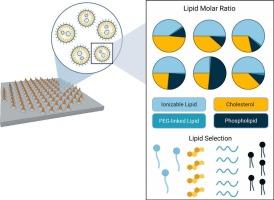mrna -脂质纳米颗粒组成对微针贴片制造过程稳定性的影响。
IF 4.3
2区 医学
Q1 PHARMACOLOGY & PHARMACY
European Journal of Pharmaceutics and Biopharmaceutics
Pub Date : 2025-08-08
DOI:10.1016/j.ejpb.2025.114819
引用次数: 0
摘要
信使RNA (mRNA)包裹在脂质纳米颗粒(LNPs)中是一项具有广泛应用前景的技术。微针贴片(MNPs)可以提高mRNA-LNPs在疫苗接种或治疗应用中的可及性。我们评估了LNP成分对MNP制备前后mRNA-LNP稳定性的影响,通过mRNA-LNP大小、包封效率和体外和体内蛋白表达的变化来评估。脂质摩尔比对LNP特性和MNP制造中承受应力的能力有显著影响。从MNP中提取后,通过荧光素酶在RAW 264.7细胞中的表达来测量,可电离脂质含量从50%提高到60%增加了mRNA的体外表达。在三种可电离脂质中,SM-102在MNP制造前后的表达量最高。在制造MNP之前,胆固醇类似物会影响mRNA-LNPs的体内表达,但在mRNA-LNP MNPs中不存在这种影响。聚乙二醇化脂质选择影响LNPs的mRNA包封,对LNPs的体外表达有强烈影响,但在体内未见这种影响。磷脂的选择对大多数mRNA-LNP特性没有显著影响,但DOTMA的使用增加了体外表达。这些数据表明,LNP成分在MNP制造前后都会影响mRNA-LNP的特性和功能。未来的mRNA-LNP MNP设计应该考虑脂质摩尔比的影响,并倾向于更高的可电离脂质含量。本文章由计算机程序翻译,如有差异,请以英文原文为准。

The effect of mRNA-lipid nanoparticle composition on stability during microneedle patch manufacturing
Messenger RNA (mRNA) encapsulated in lipid nanoparticles (LNPs) is a potent technology with broad applications. Microneedle patches (MNPs) can enhance the accessibility of mRNA-LNPs for vaccination or therapeutic applications. We evaluated the effects of LNP composition on the stability of mRNA-LNPs before and after MNP manufacturing, as assessed by changes in mRNA-LNP size, encapsulation efficiency, and protein expression in vitro and in vivo. The lipid molar ratio had a significant impact on LNP characteristics and ability to withstand stressors of MNP fabrication. An elevation in ionizable lipid content from 50% to 60% increased in vitro mRNA expression, measured by luciferase expression in RAW 264.7 cells, following extraction from an MNP. Among the three ionizable lipids tested, SM-102 had the highest expression before and after MNP manufacturing. Cholesterol analogues influenced in vivo expression of mRNA-LNPs before MNP manufacturing, but the effect was absent in mRNA-LNP MNPs. PEGylated lipid choice affected mRNA encapsulation in LNPs and had a strong effect on in vitro expression, but this effect was not seen in vivo. Phospholipid choice did not have a significant impact on most mRNA-LNP characteristics, but the use of DOTMA increased in vitro expression. These data suggest that LNP composition can affect mRNA-LNP characteristics and function both before and after MNP manufacturing. Future mRNA-LNP MNP designs should consider the effect of lipid molar ratios and favor higher ionizable lipid content.
求助全文
通过发布文献求助,成功后即可免费获取论文全文。
去求助
来源期刊
CiteScore
8.80
自引率
4.10%
发文量
211
审稿时长
36 days
期刊介绍:
The European Journal of Pharmaceutics and Biopharmaceutics provides a medium for the publication of novel, innovative and hypothesis-driven research from the areas of Pharmaceutics and Biopharmaceutics.
Topics covered include for example:
Design and development of drug delivery systems for pharmaceuticals and biopharmaceuticals (small molecules, proteins, nucleic acids)
Aspects of manufacturing process design
Biomedical aspects of drug product design
Strategies and formulations for controlled drug transport across biological barriers
Physicochemical aspects of drug product development
Novel excipients for drug product design
Drug delivery and controlled release systems for systemic and local applications
Nanomaterials for therapeutic and diagnostic purposes
Advanced therapy medicinal products
Medical devices supporting a distinct pharmacological effect.

 求助内容:
求助内容: 应助结果提醒方式:
应助结果提醒方式:


